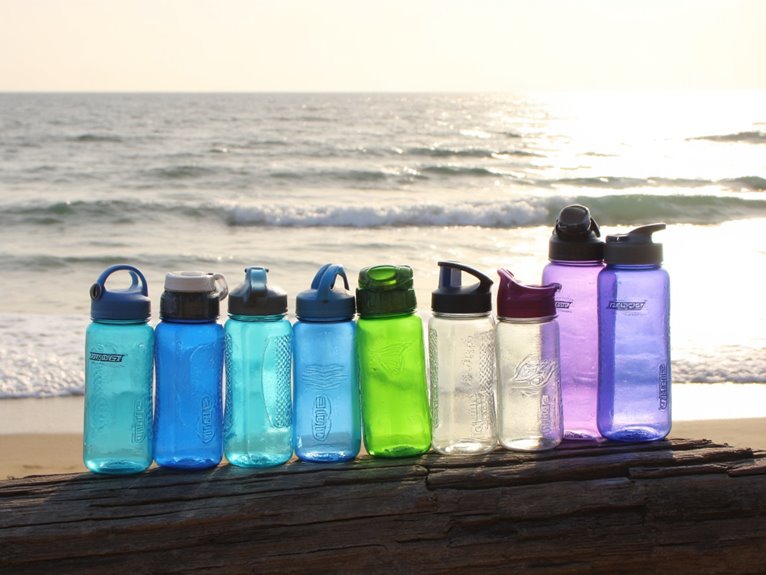Do Water Bladders Go Bad?
Water bladders, like any other device, have a limited lifespan and can deteriorate over time due to various factors. Improper maintenance, storage, and environmental conditions can cause decreased water pressure, inconsistent flow rates, and unusual noises. Corrosion, sediment buildup, and extreme temperatures can weaken the bladder's material, leading to cracks, tears, or holes. To extend the lifespan of your water bladder, regular inspections, proper cleaning, and storage are vital. By understanding the causes of degradation, you can take proactive measures to prevent failures and maintain the integrity of your water bladder – and there's more to discover on this topic.
We are supported by our audience. When you purchase through links on our site, we may earn an affiliate commission, at no extra cost for you. Learn more. Last update on 15th January 2026 / Images from Amazon Product Advertising API.
Signs of a Failing Water Bladder
A failing water bladder often exhibits subtle yet telling signs, including decreased water pressure, inconsistent flow rates, and unusual noises, which can indicate a need for maintenance or replacement.
These symptoms can be indicative of a compromised bladder that is no longer functioning at peak levels.
Decreased water pressure may result in poor showerhead performance, while inconsistent flow rates can cause uneven water distribution.
Unusual noises, such as rattling or hiss, can signal a more severe issue.
Recognizing these signs early on can help prevent more serious problems from developing, and prompt attention can prolong the lifespan of the water bladder.
Causes of Water Bladder Deterioration
Corrosion, sediment buildup, and excessive pressure fluctuations are among the primary causes of water bladder deterioration, which can lead to compromised performance and eventual failure.
These factors can weaken the bladder's material, leading to cracks, tears, or holes that compromise its integrity.
Additionally, exposure to extreme temperatures, UV light, or chemicals can also contribute to degradation.
Moreover, improper handling, such as kinking, twisting, or bending, can cause micro-tears that can propagate over time, leading to failure.
To maintain the longevity of water bladders, it is crucial to understand these causes and take preventative measures.
Improper Cleaning and Storage
In addition to the aforementioned factors, improper cleaning and storage practices can also substantially reduce the lifespan of water bladders.
Failure to properly clean and dry water bladders can lead to bacterial growth, mold, and mildew, which can compromise the material's integrity.
Improper storage, such as folding or creasing the bladder, can cause cracks and tears, allowing contaminants to enter and deteriorate the material.
Additionally, storing water bladders in direct sunlight, extreme temperatures, or humid environments can accelerate degradation.
To prevent premature deterioration, users must adhere to the manufacturer's guidelines for cleaning and storage.
Effects of UV Light Exposure
Prolonged exposure to ultraviolet (UV) light can substantially degrade the materials used in water bladders, leading to a substantial reduction in their lifespan.
The UV rays can cause the plastic materials to break down, becoming brittle and prone to cracks. This can lead to leaks and compromised integrity of the bladder.
To prevent damage, store water bladders in a shaded area or use a UV-resistant storage bag to minimize exposure.
Additionally, it is crucial to check the bladder regularly for any signs of UV damage, such as discoloration, cracks, or brittleness.
Chemical Contamination Risks
In the realm of water bladders, chemical contamination risks are a critical concern.
The presence of certain chemicals can lead to bacterial growth, compromising the safety and quality of the stored water.
In addition, the formation of toxic leachates can have severe consequences, highlighting the need for careful material selection and rigorous testing protocols.
Bacterial Growth Risks
Bacterial growth risks in water bladders pose a significant threat to human health, as they can lead to the proliferation of harmful microorganisms that can cause a range of waterborne illnesses.
When water bladders are not properly cleaned and maintained, bacteria can multiply rapidly, contaminating the stored water. This can result in serious health consequences, including gastrointestinal infections and other waterborne diseases.
Some common bacterial contaminants found in water bladders include:
E. coli: a common cause of urinary tract infections and gastrointestinal illness.
Salmonella: a bacterium that can cause food poisoning and typhoid fever.
Legionella: a bacterium that can cause Legionnaires' disease, a severe form of pneumonia.
It is essential to regularly clean and disinfect water bladders to prevent bacterial growth and guarantee safe drinking water.
Regular maintenance and proper storage can safeguard against water contamination, thereby protecting public health.
Toxic Leachates Formation
Chemical contaminants can leach into stored water from the materials used in water bladders, posing a significant risk to human health and the environment.
This can occur when the materials used in the bladder's construction, such as plastics, adhesives, or coatings, break down over time.
The resulting toxic leachates can contaminate the stored water, making it unsafe for consumption.
The risk of toxic leachates formation is higher in water bladders that are exposed to factors such as heat, light, or chemical cleaners.
To minimize the risk of chemical contamination, it is crucial to select water bladders made from food-grade materials and to follow proper maintenance and storage procedures.
Regularly inspecting the bladder for signs of deterioration and replacing it as needed can also help prevent toxic leachates formation.
Bacterial Growth and Mold
In water bladders, bacterial growth and mold can thrive under certain conditions, posing a significant threat to water quality.
Specifically, humid storage conditions, moisture accumulation risks, and stagnant water effects can create an environment conducive to microbial growth, compromising the integrity of the stored water.
Understanding these factors is vital to mitigating the risks associated with bacterial growth and mold in water bladders.
Humid Storage Conditions
When water bladders are stored in humid environments, the risk of bacterial growth and mold proliferation increases substantially. This is because moisture creates an ideal breeding ground for microorganisms to thrive.
As a result, it's essential to store water bladders in dry, well-ventilated areas to prevent the growth of unwanted organisms.
Damp basements can lead to rapid bacterial growth and mold buildup when storing water bladders.
Leaving water bladders in humid garages or sheds can create an environment conducive to mold and bacterial proliferation.
Storing water bladders outdoors in humid or rainy conditions can accelerate the growth of microorganisms.
Moisture Accumulation Risks
Moisture accumulation within water bladders creates an ideal environment for bacterial growth and mold proliferation, which can lead to compromised water quality and potential health risks.
When moisture seeps into the bladder, it fosters an environment conducive to microbial growth, contaminating the stored water. This can result in unpleasant odors, tastes, and textures, making the water undrinkable.
In addition, bacterial growth can lead to biofilm formation, which can be difficult to remove, perpetuating the contamination cycle.
To prevent moisture accumulation and mitigate the risks associated with bacterial growth and mold proliferation, proper storage and maintenance of water bladders must be guaranteed.
Regular inspections and cleaning can help maintain water quality and prevent health hazards.
Stagnant Water Effects
Stagnant water within water bladders creates an ideal breeding ground for bacterial growth and mold proliferation, leading to compromised water quality and potential health risks.
When water is left untouched for extended periods, it becomes a perfect environment for microorganisms to thrive. This can lead to the formation of biofilms, which are complex communities of microorganisms that adhere to surfaces.
Three potential consequences of stagnant water in water bladders are:
Foul Odors and Tastes: As bacteria and mold grow, they can release compounds that cause unpleasant odors and tastes in the water.
Discoloration and Sediment: Stagnant water can lead to the formation of sediment and discoloration, making the water unappealing and potentially hazardous to drink.
Health Risks: In severe cases, bacterial growth and mold proliferation can contaminate the water, posing health risks to consumers.
Regular maintenance and cleaning are essential to prevent stagnant water effects in water bladders.
Cracks and Tears in the Material
Cracks and tears in the material of water bladders can compromise the integrity of the entire system, allowing contaminants to penetrate and potentially causing catastrophic failures.
These physical breaches can occur due to various factors, including manufacturing defects, improper storage, or excessive wear and tear.
Even minor cracks can provide an entry point for bacteria, sediment, and other impurities to infiltrate the water supply.
Over time, these cracks can expand, leading to more extensive damage and potentially rendering the water bladder useless.
Regular inspections are vital to identify and address any material defects before they escalate into more severe issues.
Discoloration and Odor Issues
Discoloration and unpleasant odors in water bladders can be indicative of a more profound issue, one that compromises the quality of the stored water and potentially affects the health and safety of its consumers.
Some common manifestations of discoloration and odor issues include:
- Murky or cloudy water: Water that appears cloudy or murky may indicate the presence of bacteria, algae, or other contaminants.
- Unpleasant odors: Strong, unpleasant odors emanating from the bladder may signal the growth of bacteria or mold.
- Slimy or moldy textures: The presence of slimy or moldy textures on the bladder's surface or inside the water can be a clear indication of bacterial or fungal growth.
It is essential to address these issues promptly to maintain the safety and quality of the stored water.
Alternatively, it is crucial to tackle these issues promptly to safeguard the safety and quality of the stored water.
Extending the Lifespan of Your Bladder
Proper maintenance and regular inspection are key to extending the lifespan of your water bladder.
Regularly cleaning and drying your bladder after each use can prevent bacterial growth and discoloration.
Store your bladder in a cool, dry place, away from direct sunlight.
Inspect your bladder regularly for signs of wear and tear, such as cracks, tears, or punctures.
Replace worn-out parts, like bite valves or tubes, promptly.
Avoid using harsh chemicals or abrasive cleaners, as they can damage the bladder material.



